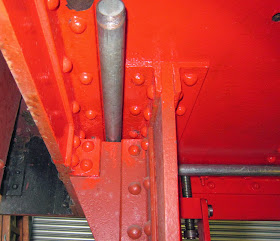From the safety valve manifold (with the flange), there is an isolating valve, a blue pressure reducing valve, a 'cross' for feeding the ejector (jet pump), a condensate drain and pressure gauge and then the ejector itself and its up-standing, tall exhaust pipe.
Off to the right of the ejector is a Gun Metal Lift Check Valve, a 'T' to the train pipe, a 'T' for a vacuum gauge, a 'T' with the vacuum relief valve in place and finally the brake operating ball valve with a Sintered Bronze Pneumatic Air Muffler (silencer).
 |
| A bit more of the beginning! |
Originally, I'd conceived the train pipe to be made from 2" nominal inside diameter pipe as used on 'big' locos. However, a discussion with Michael Patterson, who is restoring Sentinel 9366 at Quainton Road, made me appreciate that we will not be attempting to evacuate rapidly a train load of 14 Mk1 carriages. Instead we might have 2-4 carriages which will be a much less demanding task. Add to this that the ejector itself only has a 1" diameter suction pipe and it calls into question the need for 2" pipe. Add also that I have ready access to pipe threading tools that can handle up to 1.25" pipe and the case for 2" get even slimmer still.
I thus decided to use 1.25" galvanised pipe and malleable iron fittings for the vacuum system with adapters to the 2" standard fittings on other vehicles.
The basis for one such adapter is shown below. The classic steam loco's 'Swan Neck' is constructed as below. The 1.25" pipe is adapted to 1.5" fittings which can be turned down to make the correct diameter to fit the rubberised vacuum hose. A short length of support pipe may be needed to keep the pipe from slipping off (unlikely when a vacuum is present but safe if it did happen since it would break the train pipe and put the brakes on).
 |
| Swan Neck |
 |
| Rear Vacuum Pipe and Swan Neck |
This is the plan:
The rear pipe has to tuck under the buffer beam and across it.
 |
| Inside the rear buffer beam |
 |
| Hand-brake mechanism |
 |
| Inside the frame below the footplate looking rearwards |
The pipe then has to come forward to where it will 'T' off upwards to the vacuum ejector suction port and brake operating lever.
 |
| Forwards through a restricted space |
 |
| Between the upward exhaust pipes and the rear of the water tank on the left. |
 |
| Space to the left of the three insulated pipes |
The first few steps are shown below.
First it tucks under the buffer beam via a right angle union connection to allow the Swan Neck to be aligned rearwards.
 |
| Tucking under the buffer beam |
 |
| Under the footplate |
 |
| Avoiding the handbrake |
 |
| Right angled union |
The pipe advances forwards through he gap at the top of a supporting bracket.
 |
| Handy gap for a pipe |
 |
| Section of plank supporting the pipe |
No comments:
Post a Comment